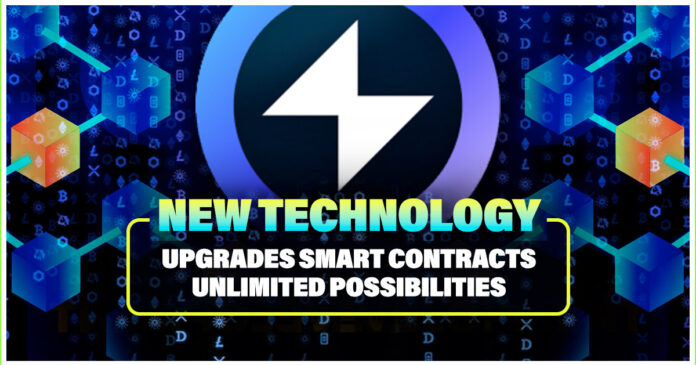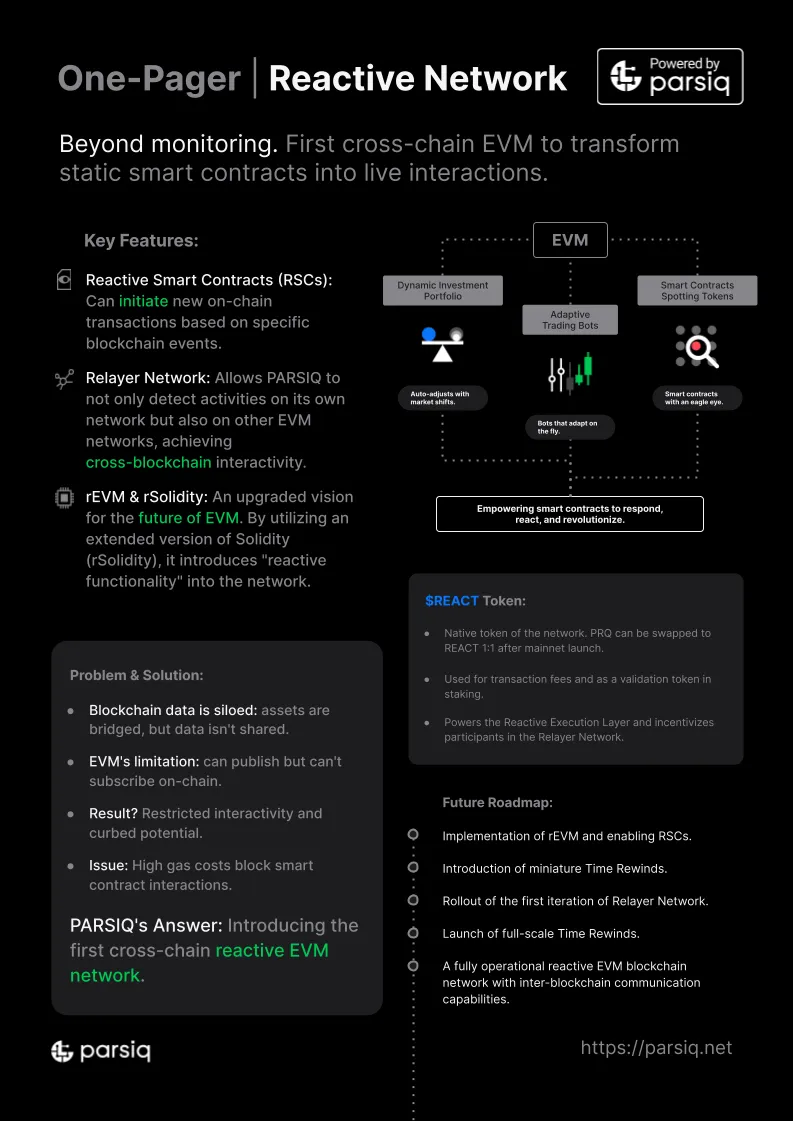PARSIQ is emerging as one of the biggest players in the Web3 infrastructure field, with multiple innovations and impressive accomplishments. The project is making immense contributions to Web3, helping regular users like us connect with blockchain networks.
PARSIQ is planning to launch a new product known as the Reactive Network. Like most of its services, the Reactive Network answers a common problem in Web3. What is this problem? There’s a huge demand for better and more automation in Web3.
In addition, there’s more demand for interactive smart contracts. But what’s lacking is the absence of smart contracts that react to on-chain events, and that’s what PARSIQ achieves with its Reactive Smart Contracts. Let’s look at this in detail.
What makes this service unique?
To understand the uniqueness of the Reactive Network, we have to look at its features. The Reactive Network introduces the following features to Web3:
- Reactive Smart Contracts (RSCs): They make new on-chain transactions based on specific blockchain events.
- Relayer Network: This helps PARSIQ find activities on different EVM networks, including their own. This allows for interactions between different chains, making RSCs more useful.
- rEVM and rSolidity: These are improvements for the future of EVM. rSolidity is like a more advanced version of Solidity, bringing “reactive functionality” to the network. Developers will be able to program their apps with this variation on the programming language.
One of the perks of the Reactive Smart Contracts is its flexibility. Developers have tweaked the Ethereum Virtual Machine (EVM) and expanded the Solidity language to allow Reactive Smart Contracts (RSCs) to smoothly engage with other smart contracts in the same setting.
They say the greatest journeys all start with a single step, so we hope you'll all join us in this first step on the road to bringing #Web3 infrastructure to the next level!
Care to tag along? 🤝
Follow our work at https://t.co/9gcRxhXgqM pic.twitter.com/0lcjGO5tCH
— Reactive Network | powered by PARSIQ (@0xReactive) December 7, 2023
Another benefit of this tool is that it can source data from different blockchains. So within EVM, you can source data from Avalanche to then use on Polygon.
RSCs make it easier to integrate different chains. Furthermore, it enables decentralized apps (dApps) to easily gather data and respond to new blocks across various chains simultaneously. Like in the above example, where we find out something happened on Avalanche so now we want to transact on Polygon because it happened.
RSCs is a game-changer in several ways. First, it will improve how developers create. Secondly, it will impact different blockchain sectors such as gaming and NFTs, DeFi and even DAOs. Let’s explain these in better detail.
One of the core concepts of Reactive Network is transaction parallelization.
This removes one of the key restrictions of many blockchains and allows for cheap computation and unprecedented throughput
1/2 pic.twitter.com/w2ajH9Q0xG— Reactive Network | powered by PARSIQ (@0xReactive) December 29, 2023
Want to learn more about Reactive Smart Contracts?
We have a dedicated section on our blog where you can read about the next big game-changer heading to Web3, IFYKYK 🔥https://t.co/QSPyKdSiCv
— Reactive Network | powered by PARSIQ (@0xReactive) December 5, 2023
The Reactive Network will change how developers create apps
The Ethereum Virtual Machine (EVM) has been helpful in the blockchain world, but it has limitations in reacting to on-chain events. Reactive Network will fix this issue.
The launch of Reactive Smart Contracts is an improvement in Web3. These contracts can perform specific actions when a predefined on-chain event, like event ‘X’, occurs.
⚡️ Big news! Introducing Reactive Network by PARSIQ, a groundbreaking decentralized layer for cross-chain #EVM interactivity! 🚀
🔗 Announcement: https://t.co/oPAO9K7aAw
🔗 One-pager: https://t.co/A7Oh2rL9qS pic.twitter.com/t52N4xJuw6— PARSIQ | #BUIDL your Web3 Unicorn (🌊,🦄) (@parsiq_net) September 27, 2023
Reactive Smart Contracts have the potential to transform how developers create applications, bringing in a host of new functionalities for dApps. Some of the use cases of this solution include:
- portfolio investing with swift and precise rebalancing
- advanced trading bots that adjust to market shifts.
- identification of upcoming intriguing tokens,
- ensuring well-funded collateralized positions, and much more. The possibilities are vast, marking a significant leap forward in the capabilities of smart contracts.
Want to learn more about Reactive Smart Contracts?
We have a dedicated section on our blog where you can read about the next big game-changer heading to Web3, IFYKYK 🔥https://t.co/QSPyKdSiCv
— Reactive Network | powered by PARSIQ (@0xReactive) December 5, 2023
“Reactive Network” by @parsiq_net is coming
Get ready to $REACT ⚡️
A new beginning for blockchain smart contracts
— CryptoAdvocate 🇦🇺 (@ethadvocate) January 6, 2024
How will the Reactive Network Improve NFTs and Gaming?
The Reactive Network’s relevance extends to NFTs and the Web3 gaming space. PARSIQ’s Reactive Network has the potential to revolutionize how you earn and use NFTs in Web3 games.
Imagine this: one smart contract tuning in and responding to the happenings of another smart contract. Games could set up these underlying smart contracts to react dynamically to in-game events. This triggers updates to the NFTs the players own. It’s like giving NFTs a voice in the game’s story, creating a more immersive and interactive experience for players.
#Blockchain will grow in 2024 with advances for Smart Contracts such as those with "Reactive Network" ⚡️ by @parsiq_net
More value & utility on;
🔷 Ethereum
🔷 Avalanche
🔷 Polygon
🔷 Binance Smart Chain
🔷 Optimism
🔷 Arbitrum
🔷 Metis📘 https://t.co/mPiyKSzd5p$REACT ⚡️
— CryptoAdvocate 🇦🇺 (@ethadvocate) January 5, 2024
Here’s another scenario. Picture a genius-level smart contract seamlessly woven into your favorite game, keeping tabs on every epic moment you conquer. The smart contracts showcase your in-game triumphs. This includes whether you’re leveling up, defeating a formidable boss, or achieving gaming greatness. It’s like your own personal cheer squad.
How Reactive Smart Contracts will look like in DeFi
DeFi has had some back-and-forth in recent months. But the Reactive Smart Contracts have the potential to add more appeal to the sector and bring in more investors. The Reactive Network will provide a set of tools to advance the DeFi space further.
These tools can enable:
- Development of new types of derivatives using on-chain indicators.
- Liquidity pools are used to adaptively concentrate liquidity according to market volatility.
- Lending protocols to automatically handle risk and collateralization.
"Reactive Smart Contracts" ⚡️ by @parsiq_net
The Superhero #blockchain needs in a multi chain world
Able to instantly communicate between smart contracts & across #blockchains
📘 https://t.co/mPiyKSzd5p$REACT ⚡️ pic.twitter.com/dwilDWKuga
— CryptoAdvocate 🇦🇺 (@ethadvocate) January 3, 2024
Reactive Network will improve DAOs
The Reactive Network will bring more automation and decentralization to DAOs. The current system requires certain individuals to implement voting decisions. But the Reactive Smart contracts can automate this process.
So, one contract follows the events of a voting process. And once voting is complete, it will send an event for the Reactive Network to pick on. Finally, a secondary smart contract will then execute the proposal. This makes DAOs more decentralized.
@HivemindCap @AptosLabs @unit_410 @Securitize @hirosystems @fulcrumhq
"Reactive Network" ⚡️ by @parsiq_net launching in 2024
Turbocharging the following & more;
🔥 Smart Contracts
🔥 Layer 1
🔥 Layer 2
🔥 DeFi
🔥 GameFi
🔥 RWARead here 📗 https://t.co/cwqzx7SiBl$REACT ⚡️
— CryptoAdvocate 🇦🇺 (@ethadvocate) January 2, 2024
Is a token available?
At the heart of the advanced Reactive Network is the REACT token. Its main jobs include:
- being used as payment for gas,
- covering costs for RSC post-block transactions,
- rewarding participants who help with cross-chain event log consensus activities.
As soon as the network launches, PRQ can be easily swapped 1:1 to REACT on the Reactive Network mainnet.
Want to learn more about Reactive Smart Contracts?
We have a dedicated section on our blog where you can read about the next big game-changer heading to Web3, IFYKYK 🔥https://t.co/QSPyKdSiCv
— Reactive Network | powered by PARSIQ (@0xReactive) December 5, 2023
In conclusion, PARSIQ’s Reactive Network is the next step to making smart contracts smarter. And making Web3 more decentralized. The Reactive Network isn’t up yet. But it’s coming soon! Follow PARSIQ’s social media pages for more updates.





























